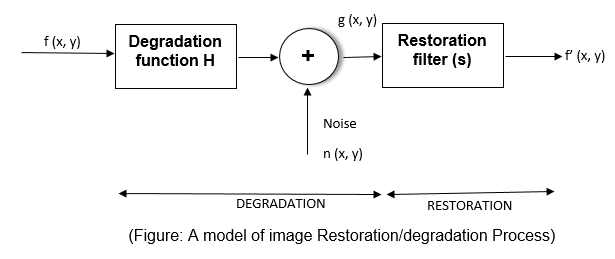IMAGE RESTORATION MODELS
The principal
goal of restoration technique is to improve an image in some predefined sense.
Image restoration is concerned with filtering the observed image to minimize
the effect of degradations. Image restoration refers to removal or minimization
of known degradations in an image. This includes deblurring of images degraded
by the limitation of a sensor or its environment, noise filtering or non-linarities
due to sensors.
The
fundamental result in filtering theory used commonly for image restoration is
called the Wiener filter. This
filter gives the best linear mean square estimate of the object from the
observation. It can be implemented in frequency domain by the fast unitary transforms.
Other image restoration methods are: - least
squares, constrained least squares, and spline interpolation methods. Other
methods such as likelihood, maximum entropy, and maximum posteriori are nonlinear
techniques that require iterative solutions.
Image
Restoration Models: - There are different models of image
restoration given below:
1) Image
formation models.
2) Detector
and recorder.
3) Noise
models.
4) Sampled
observation models.
5) Detector and Recorder Models.
Here, the degradation process
is modeled as a degradation function together with an additive noise term,
operates on input image f (x, y) to produce a degraded image g (x, y). The
restoration approach is based on various types of image restoration filters.
1.
Image
Formation Model: - The
study of image formation encompasses the radiometric and geometric processes by
which 2D images of 3D objects are formed. In the case of digital images, the
image formation process also includes analog to digital conversion and
sampling.
Diffraction-limited coherent systems
have the effect of being ideal low-pass filters.
Motion blur occurs when there is
relative motion between the object and the camera during exposure. Atmospheric turbulence is due to
random variations in the refractive index of medium between the object and the
image system. Such degradation occurs in the imaging of astronomical images.
Examples of Spatially Invariant models: -
1)
Diffraction limited, coherent (with
rectangular aperture)
2)
Diffraction limited, incoherent (with
rectangular apeture)
3)
Horizontal motion
4)
Atmospheric turbulence
5)
Rectangular scanning aperture
6)
CCD interactions
2. Detector and Recorder Model: -
The
response of image detectors and recorders is generally nonlinear. For example,
the response of photographic films, image scanners, and display devices can be
written as
g =
awb
where
a and b are device-dependent constant and w is the input variable.
3. Noise Models: - The
principal source of noise in digital images arise during image acquisition or
transmission. The performance of imaging sensors is affected by a variety of
factors, such as environmental conditions during image acquisition, and by the
quality of the sensing elements themselves.
For example: In
acquiring images with a CCD camera, light levels sensor temperature are major
factors affecting the amount of noise in the resulting image.
An image transmitted using a wireless network
might be corrupted as a result of lightning or other atmospheric disturbance.
Some important Noise Probability Density
Functions: -
1)
Gaussian
noise: - Because of its mathematical tractability in both the
spatial and frequency domains, Gaussian (also called normal) noise model are used
frequently in practice. The PDF of a Gaussian random variable, z, is given by:
P(z)
= 1 /Ö2πσ
x e -(z-z’)/2σ2
2) Rayleigh
Noise
3) Erlang
(gamma) Noise
4) Exponential
Noise
5) Uniform
Noise
6) Impulse
(salt-and-pepper) Noise
7) Periodic
Noise

















simple and easy :)
ReplyDeleteAwesome article.
ReplyDeleteImage Shadow
high end beauty retouching
background removal service
image masking services
mmorpg
ReplyDeleteinstagram takipçi satın al
tiktok jeton hilesi
sac ekim antalya
instagram takipçi satın al
Instagram Takipçi Satin Al
Mt2 pvp serverler
instagram takipçi satın al
ataşehir arçelik klima servisi
ReplyDeleteüsküdar toshiba klima servisi
beykoz beko klima servisi
ataşehir lg klima servisi
çekmeköy alarko carrier klima servisi
tuzla bosch klima servisi
ümraniye samsung klima servisi
kartal mitsubishi klima servisi
pendik beko klima servisi